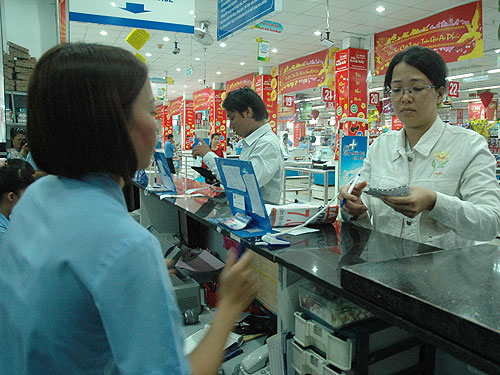VietNamNet Bridge – Experts have pointed out that a breakthrough policy is
needed to help develop the non-cash payment in Vietnam.
 |
|
|
40 million cards issued, used to withdraw money
Experts have pointed out that if nothing changes, the card market would not develop and the ambitious goals set up in the plan would never become true.
Commercial banks have been trying to offer a lot of preferences in issuing cards in an effort to attract more customers. Some banks issue cards free of charge, offer price discounts when making payment with cards.
However, analysts have pointed out that the banks have only been trying to increase the number of cards issued, while they have not paid attention to the efficiency. Some banks only focus on issuing new cards, but do not spend money to develop their ATM systems.
Approximately 40 million cards have been issued, but tens of millions of the cards are “dead cards”, i.e. they have not been used. Banks came to industrial zones, export processing zones, universities and general schools to offer cards free of charge to workers and students. However, since the day of issuance, a lot of cards have been left idle in the wallets of people.
The Vietnam Card Association has forecast that the percentage of dead cards in the whole banking system may reach 50 percent.
There are 49 card issuers and 200 card brands. According to Duong Hong Phuong, a senior executive of the State Bank of Vietnam, the bank card services are considered the most dynamic sector among non-cash payment means with the high growth rate of 50-60 percent per annum in recent years.
However, over the last 20 years, since the day the first card was issued in Vietnam, cards have been mostly used to withdraw cash from ATMs.
Meanwhile, the development of POS system is not as good as expected. There are several POS at the same shop, which leads to the low use level of POS – a big waste of investment money. Meanwhile, many goods suppliers do not want to install POS, because they have to bear the discount rates of 1.8-2.5 percent of the transaction values, while they have to make public their real revenue.
Card market needs a push to develop
Nguyen Van Dung, Deputy Director of the HCM City Branch of the State Bank, said that the Ministry of Finance should consider reduce tax on the businesses based on the payment revenue via POS. This would encourage sellers to accept the payment through cards.
Meanwhile, Phuong from the State Bank thinks that it is necessary to encourage the development of multi-functional cards, make investment in the infrastructure for the POS network at shopping malls, hotels, amusement parks. Goods and service providers should offer fee reductions, price discounts in order to encourage people to make payment through POS.
Meanwhile, Nguyen Thu Ha, Chair of the Vietnam Card Association, said that at first, the State Bank should lay out the policy under which making payment with cards is compulsory for the businesses in retail fields. After that, the compulsory payment through cards will be extended to the businesses in other fields.
In related news, commercial banks are considering applying necessary measures to ensure the information security for card users. Some banks have shifted to use chip cards instead of magnetic cards.
Source: NLD